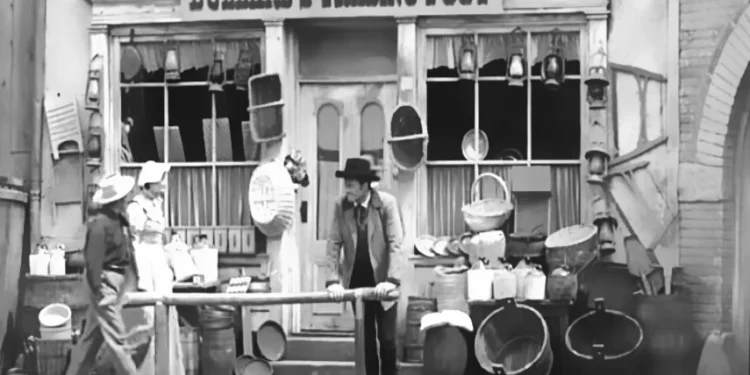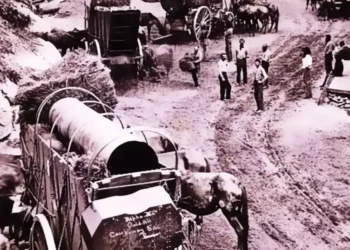By Cris Alarcon, InEDC Writer. (April 6, 2025) — In the annals of television history, “The Californians” stands out as a series that delved into the complexities of California’s Gold Rush era. A particularly notable episode, “Hangtown,” which aired on November 18, 1958, offers a compelling narrative that resonates with the heritage of El Dorado County.
In “Hangtown,” Marshal Matthew Wayne, portrayed by Richard Coogan, honors a dying man’s last request by venturing into the ominously named town of Hangtown. The episode intricately weaves themes of justice and morality, reflecting the turbulent times of the 1850s. Directed by Sean McClory and penned by Sid Harris, the storyline captures the essence of frontier challenges.
The setting of Hangtown is particularly significant for residents of El Dorado County, as it mirrors the historical town of Placerville. Originally known as Hangtown due to the swift frontier justice that was often administered there, Placerville became a focal point during the Gold Rush. The town’s moniker was a stark reminder of the era’s rough-and-ready approach to law and order.
For those interested in viewing this slice of television history, “Hangtown” is available for streaming on Peacock. Additionally, the episode can be accessed on YouTube, providing an opportunity for both nostalgia and historical reflection.
Reflecting on the episode’s impact, television historian Mark Johnson noted, “‘Hangtown’ not only entertained but also shed light on the moral dilemmas faced by those living during the Gold Rush era.” Such narratives continue to offer valuable insights into the complexities of California’s formative years.
By revisiting episodes like “Hangtown,” viewers gain a deeper appreciation for the rich tapestry of El Dorado County’s history and the enduring stories that have shaped its identity.
This script excerpt is from The Californians, a mid-1950s Western television series, and it’s loaded with rich historical themes and frontier drama. The storyline touches on several issues relevant to California’s early statehood and post-Gold Rush days — namely racial tension, vigilante justice, land and claim disputes, and the often blurred lines between lawmen and land barons.
Here are some key observations and themes from this segment:
Historical and Cultural Themes
-
Racial Prejudice: The term half-breed is used pejoratively to describe the children of Mexican and American unions, reflecting real historical racism in early California. Despite being born in the state, these individuals were often considered second-class citizens.
-
Land Dispossession: Stuart Sanchez and others were run out of Hangtown by the so-called “Law and Order Committee,” which echoes the documented historical practice of forcibly removing Mexicans and mixed-race Californians to seize their gold claims.
-
Power and Corruption: Reed Bullard is portrayed as a powerful figure who owns the town’s businesses and mine, and possibly controls the Sheriff as well — a classic Western trope highlighting corruption and power imbalance.
-
Justice vs. Law: Matt Wayne, the Marshal from San Francisco, represents the lawful outsider challenging local injustice. He’s the moral compass who sees through the facade of “law and order” when it’s really just a cover for prejudice and theft.
Character Highlights
-
Matt Wayne: Calm, determined, and principled. He’s our hero, trying to find Stuart Sanchez while navigating hostility in Hangtown.
-
Florita Bowen: A young woman of Mexican heritage who has survived personal loss and fever, with a cautious heart and secrets of her own.
-
Sheriff of Hangtown: Wears the badge but may not carry the honor. He’s either complicit or too weak to stand up to Bullard.
-
Reed Bullard: Smooth-talking, manipulative, and very likely the antagonist behind the forced evictions.
Setting and Atmosphere
-
The mood is tense and suspicious. From the moment Wayne steps into town, he’s under scrutiny. Dialogue is clipped and heavy with meaning. The music — both mournful and suspenseful — underscores the gravity of injustice.
-
Hangtown (the old name for Placerville) is used here not just as a backdrop but a symbol of the lawless, gold-driven chaos that defined much of early California life.
PLACERVILLE GAZETTE — SPECIAL BULLETIN
Marshal from San Francisco Rides into Hangtown, Seeks Missing Stage Driver Amid Rising Tensions
Hangtown, El Dorado County — Spring of ‘52
A stranger rode into town this week—a lawman bearing a San Francisco badge and a quiet resolve. Marshal Matt Wayne arrived in Hangtown on the heels of a friend’s dying wish: deliver a message to one Stuart Sanchez, a Mexican-born miner and stage driver, now gone missing.
Marshal Wayne’s inquiries stirred unease among the local townsfolk, many of whom have grown tight-lipped since the rise of the self-styled Law and Order Committee, led by powerful mine boss Reed Bullard. Mr. Sanchez, along with others of Mexican and mixed heritage—referred to in hushed tones as “half-breeds”—was reportedly driven out months prior in a mass expulsion that seized unregistered and disputed claims.
The Sheriff, elected but curiously deferential to Bullard, warned Wayne to cease his inquiries. But the Marshal remained undeterred, keen to find answers in the dust of abandoned shacks and the whispers of a frightened hotel maid named Florita Bowen.
Tensions now run high as the Marshal’s presence has upset the uneasy balance in a town built on gold, guarded by guns, and shadowed by prejudice. The days ahead may well reveal whether justice will ride tall—or be buried beneath Hangtown’s dirt roads.
Filed by an Unnamed Correspondent
From the Dust and Truth of the California Frontier










